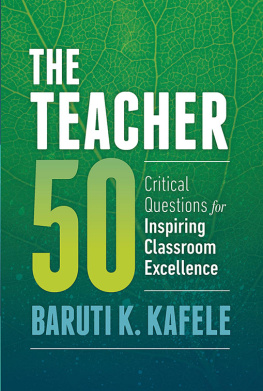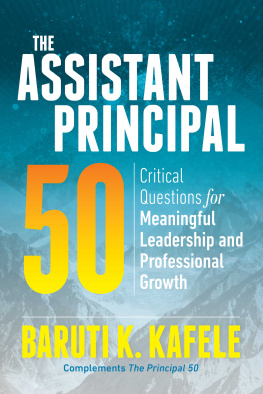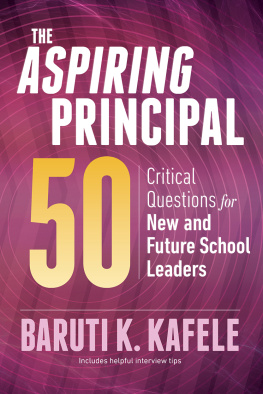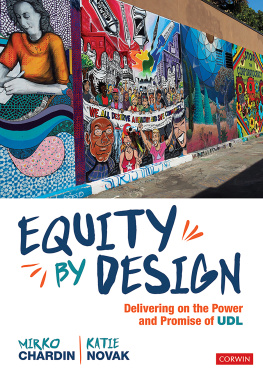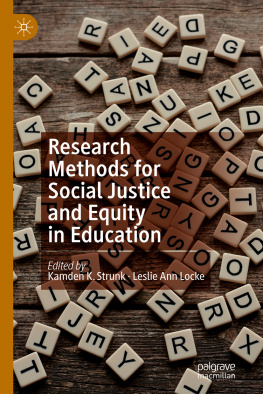Contents
Guide
Pages for The Equity and Social Justice Education 50
Dedication
....................
I know definitively that if George Floyd and Breonna Taylor were alive today, I would not have written this book at this juncture in my literary journey. Their deaths compelled me to write this book now, so it is only right and fitting that I dedicate The Equity & Social Justice Education 50 to their memories.
Acknowledgments
....................
I want to thank Mrs. Joy Scott Ressler, my editor, for bringing to this book the magic that she brought to both The Assistant Principal 50 and The Aspiring Principal 50; ASCD content acquisitions director Ms. Genny Ostertag, for continually believing in me; and Stefani Roth, for always, always having my back. I remain grateful for the three of you.
Introduction
....................
Sometime between 2016 and 2017, I observed a seismic shift in the education landscape that centered around one word: equity. It was quite interesting for me because, prior to that time, my use of the word was solely associated with home ownership and the net worth of a home. When I started hearing various lecturers going hard on the word, I paid attention. In fact, it resonated with me on a personal level in a way that nothing else in education has in my 33 years in the field. There are so many new fads and trends that come and go in education; I pay attention to some and somewhat ignore those that, to my mind, are here today and gone tomorrow. Regarding equity, I concluded early on that it was here to stay as far as my work is concerned because I felt that, at heart, Id always been the embodiment of an equity practitioner from the time I entered the education profession. I just didnt have a word to attach to it.
It is a given that we all have a story, and in most cases, it is quite inspiring and compelling. Although my story is relevant to most K12 students, throughout my 21 years as a teacher, assistant principal, and principal, I never once shared it with my students. While I knew that my story could inspire them, at the time, I just wasn't comfortable sharing it. In fact, I prayed that it never made its way to the parents of my former classmates. And then comes this word: equity. Wow!
As the word equity emerged onto the education landscape with a vengeance, and as I was already five or six years removed from my principalship, I developed this sense of regret. I could have kicked myself for not having shared my storywhere I'd come from, how I'd evolved, how I got to where I wasas so many of my students would have identified with and benefited from it. They might have viewed me through a different lens as wellone through which I would likely have appeared more relatable and relevant, a success story. In other words, the word equity evoked for me individuality, identity, and voice. Said differently, it evoked student individuality, student cultural identity, and student voice. Those three wordsindividuality, identity, and voice and the meanings behind them, are critical for children in any classroom (as I will detail as we get deeper into this book).
To lend further clarity, when I refer to my story in the context of equity, I want to briefly bring you inside my academic world as a Black male who grew up in East Orange, New Jersey, with his mother and maternal grandmother during two critical decadesthe '60s and the '70s. In elementary school, I was a good student. I didn't experience any academic, social, or emotional challenges. By the time I completed middle school, however, I had completely lost interest in school as a result of a variety of social and emotional challenges that arose and, consequently, led me to feel and internalize the belief that I didn't have the ability to learn and to become successful. I mean, I genuinely did not feel that I any longer had the capacity to make sense of or retain what was being taught to me in class. Throughout my high school years, I attended four high schools over a five-year periodultimately graduating with a grade point average of 1.5! I went on to a two-year junior college, where I spent five years as a full-time student and from which I never graduated. In fact, I didn't do much more than hang out in the student center with like-minded friends (all of whom are now successful). After my stint at junior college, with nowhere near the credits needed to graduate, I enrolled in a four-year collegeKean University, here in New Jerseyand graduated summa cum laude in two years, which brings me to equity and social justice.
As I have written in various publications about the many factors that led me to get myself together and become successful, I want now to focus on two of themdiscovering African American history and learning how to learn.
Discovering African American History
My first day on campus, I stumbled on an African American history book in the campus libraryTo Kill a Black Man by Louis E. Lomaxthat draws parallels in the lives of Dr. Martin Luther King Jr. and Malcolm X and that completely blew my mind. I was so intrigued and inspired by what I read that I wanted to read more. Because of that book, I became a voracious reader of African American history overnight. I read every book about the African American experience that I could get my hands on. Why? Because reading African American history took me on a never-ending journey of self-discovery. As my eyes opened to the reality of who I was historically and culturally (my initial foray into issues of social justice), I concluded that greatness was within me and that I had no choice but to excel academically and, later on, professionally in a social justice context as a teacher and a principal. I walked into my classes with supreme confidence in my ability to excel. Through an equity lens, I was being fed what I needed to regain my confidence and become an effective classroom teacher and, eventually, school leader.
Learning How to Learn
Armed with a firm grasp of African American history, I needed a firm grasp of the mechanics of learning that spoke to how I learned and how my brain processed information. As I hadn't experienced academic success since elementary school, at 23, I didn't know how to achieve academic success or learn. Instinctively, I went into each class with notebooks and literally wrote down every word uttered by my instructors. Absent note-taking skills, I simply wrote, word for word, both what was said and what was written on the board. I then went back to my room and studied my handwritten notes thoroughly while I read my textbooks and highlighted everything that I felt pertained to the lectures. I got to a point where I both received and anticipated receiving As on exams. I maintained a 4.0 GPA throughout my tenure at Kean University, from which I graduated in 1986 as the highest-achieving African American student that year.
It wasn't until 30 years after graduating, with the onslaught of the word equity, that I definitively understood the academic transformation that I'd experienced at Kean University. Although my driving forcethe study of African American history and how it was transforming the way that I viewed myselfwas clear to me, the mechanics of learning was a different story entirely. As I reflected on the entirety of my K12 years, what stood out for me was that the instruction was highly auditory. When I became a principal and, subsequently, an instructional leader, it became clear to me as I realized that many of my students were not auditory learners that I, too, was not an auditory learner. However, I had not yet figured out how I processed information as an undergraduate. When equity began to be focused on in schools, I made the connection that children in a given classroom are brilliant but it is the teacher's responsibility to discover how each student makes sense of, processes, and, ultimately, learns what is being taught. As I reflected on my transformation, I realized that I'd been successful at Kean because I was able to learn how I learn bestby


